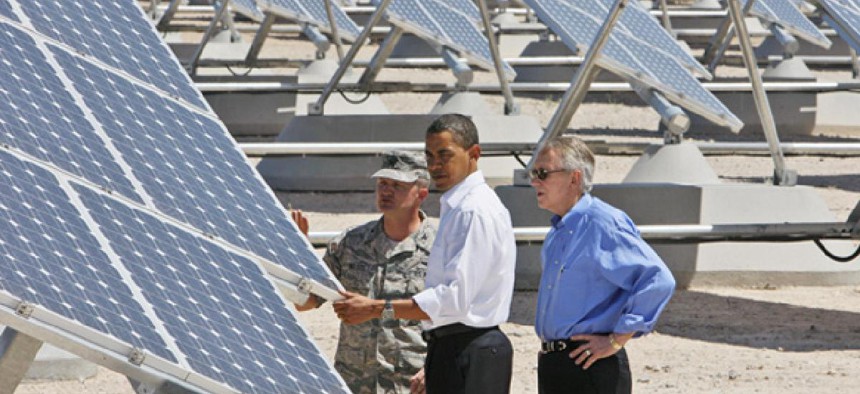White House budget to expand clean energy programs through Pentagon
Putting the increases in the Defense budget makes them a less likely target for Republican lawmakers.
The White House believes it’s figured out how to get more money for clean energy programs touted by President Obama without having it become political road kill in the wake of the Solyndra controversy: Put it in the Pentagon.
While details are thin on the ground, lawmakers who work on both energy and defense spending policy believe the 2013 budget request to be delivered to Congress on Monday probably won’t include big increases for wind and solar power through the Energy Department, a major target for Republicans since solar-panel maker Solyndra defaulted last year on a $535 million loan guarantee from the DOE.
But they do expect to see increases in spending on alternative energy in the Defense Department, such as programs to replace traditional jet fuel with biofuels, supply troops on the front lines with solar-powered electronic equipment, build hybrid engine tanks and aircraft carriers, and increase renewable energy use on military bases.
While Republicans will instantly shoot down requests for fresh spending on Energy Department programs that could be likened to Solyndra, many support alternative-energy programs for the military.
“I do expect to see the spending,” said Rep. Jack Kingston, R-Ga., a member of the House Defense Appropriations Subcommittee, when asked about increased investment in alternative-energy programs at the Pentagon. “I think in the past three to five years this has been going on but that it has grown as a culture and a practice and it’s a good thing."
“If Israel attacks Iran and we have to go to war and the Straits of Hormuz are closed for a week or a month and the price of fuel is going to be high, and the question is, in the military, what do you replace it with? It’s not something you just do for the ozone – it’s strategic.”
Sen. Lindsey Graham, R-S.C., who sits on both the Senate Armed Services Committee and the Defense Appropriations Subcommittee, said, “I don’t see what they’re doing in DOD as being Solyndra.”
“We’re not talking about putting $500 million into a goofy idea,” Graham told National Journal. “We’re talking about taking applications of technologies that work and expanding them. I wouldn’t be for DOD having a bunch of money to play around with renewable technologies that have no hope. But from what I understand there are renewables out there that already work.”
A senior House Democrat noted that this wouldn’t be the first time the Pentagon has been deployed as a way to advance policies that wouldn’t otherwise be supported.
“They did it in the ’90s with medical research,” said Rep. Henry Waxman, D-Calif., ranking member of the House Energy and Commerce Committee. In 1993, when funding was frozen for breast-cancer research programs in the National Institutes of Health, Congress boosted the Pentagon’s budget for breast-cancer research – to more than double that of the health agency’s funding in that area.
NEXT STORY: Defense opens 14,000 new roles to military women



